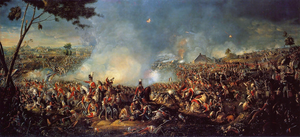
William Sadler II (c. 1782—1839),[1] also known as William Sadler the Younger, was an Irish painter. He was a noted landscape painter who is known for his depiction of the Battle of Waterloo.
YouTube Encyclopedic
-
1/2Views:1 1131 689
-
Whats It All Mean: William T. Wiley in Retrospect
-
Robert Warner on Ray Johnson
Transcription
Life
William Sadler II was born around 1782.[2] He was the son of William Sadler, an English portrait painter and engraver who came to Ireland as a boy with his father.[3]
Sadler lived at a number of different addresses before settling in Manders' Building, Ranelagh, where he died on 19 December 1839. With his wife, Caroline, Sadler had a number of children including 2 sons became painters, the eldest being William Sadler III, and Rupert Sadler. William Sadler III emigrated to the United States.[2][4]
Career
Sadler, who grew up in Dublin, exhibited his paintings between 1809 and 1821 in the city. In 1828 and 1833 he exhibited at the Royal Hibernian Academy. Sadler also taught painting and one of his pupils was James Arthur O'Connor. Sadler was greatly influenced by Dutch genre painting and made many copies of the Old Masters.[2] He mostly painted in oils, with many of his works featuring Dublin's cityscape, crowds, or military scenes painted on mahogany wood panels.[4]
Sadler, his father, and his son, William, all painted in a similar style which has led to some confusion in identifying which Sadler produced some paintings. Though Sadler is generally considered the better of the three artists.[5]
List of paintings
- A View of the Salmon Leap, Leixlip, c. 1810 – Oil on panel; National Gallery of Ireland.
- Donnybrook Fair, c. 1839 – Oil on panel; Collection of Brian P. Burns.
- A View of the Deputy Master's House at the Royal Hospital, Kilmainham, overlooking Phoenix Park[2]
Further reading
- Hutchinson, John. James Arthur O'Connor. Dublin: The National Gallery of Ireland, 1985. ISBN 0-903162-28-8.
References
- ^ "Collections Online | British Museum". www.britishmuseum.org. Retrieved 29 November 2022.
- ^ a b c d Strickland, Walter G. (1913). "William Sadler, Landscape Painter". A Dictionary of Irish Artists. Retrieved 29 November 2022.
- ^ Strickland, Walter G. (1913). "William Sadler, Historical and Portrait Painter". A Dictionary of Irish Artists. Retrieved 29 November 2022.
- ^ a b "William Sadler, Irish Landscape Artist: Biography, Paintings". www.visual-arts-cork.com. Retrieved 29 November 2022.
- ^ "William Sadler 1782 - 1839, Irish Artist". adams.ie. Retrieved 29 November 2022.
